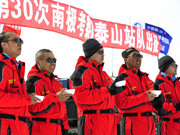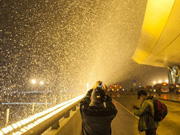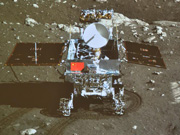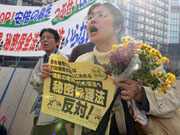 |
Sitting in the western section of Yanjiang Road of Fancheng District, Xiangfan City, Hubei Province, Migong Temple was originally named as Mijia Hut, a memorial temple in commemoration of Mi Fu, a great calligrapher, painter and connoisseur in Northern Song Dynasty (960—1127). With his “mania” behavior and manner, Mi Fu (1051-1107) gained his nicknamed of Mad Mi and was listed together with Cai Xiang, Su Shi, Huang Tingjian as Top Four Calligraphers in Song Dynasty (960—1279). Though no written record is available about the origin of Migong Temple, books like History of Xiangyang County noted that Migong Temple was destroyed by war in the turning period of late Yuan and early Ming dynasties and rebuilt in Ming Dynasty; Zheng Jizhi, Tutor of Crown Prince and Minister of Official Personnel Affairs, made inscription for Stele for Pedigree of Mi Clan in the 47th Year under the reign of Wanli (619), introducing the development of residence of Mi’s family. Spanning a land of 16,000 square meters, Migong Temple is an architecture complex featuring a major building extending along central axis with three yards. The middle hall is the venue where offspring of Mi’s family worship their ancestors. And what followed is a quadrangle courtyard called Baojin Hall, which is surrounded by stele corridors at both sides measuring 160 square meters and accommodating a great quantity of carved inscription of generations. Rebuilt items like Yanggao Hall, Pure Pavilion, East Garden and West Garden are also part of the architecture complex, which is embraced by lush green plants and artificial rocks, boasting serenely graceful air. In 1956, Migong Temple and carved inscriptions were included into list of Cultural Relic under Key Provincial Protection by Hubei Government.
Zheng Jizhi, Tutor of Crown Prince and Minister of Official Personnel Affairs, made inscription for Stele for Pedigree of Mi Clan in the 47th Year under the reign of Wanli (1619) in Ming Dynasty, introducing the development of residence of Mi’s family.
In the 11th Year under the reign of Emperor Kangxi in Qing Dynasty (1672), Wu Gongwan and Zheng Wuyun visited Migong Temple and found one remnant part of Stele for Pedigree of Mi Clan. The very another part of the stele was found by Jiangnan Education Commissioner and Censor Shao Siyao in the 32th Year under the reign of Emperor Kangxi in Qing Dynasty (1693) when he visited Mi Fu’s hometown.
Upon renovation during the years under the reign of Emperor Yongzheng, five buildings in the architecture complex were brought into the uniform style with white walls and black tiles. A stele reading “Mi Fu’s Hometown” was erected in front of these newly-built buildings.
In the 5th Year under the reign of Emperor Yongzheng (1727), local magistrate of the prefecture Gao Mao ordered to build a bridge over mound to connect with the memorial temple. A gate was left through mound for the convenience of passage. Also, a pavilion was built over mound and called Miandun Pavilion. Some steles inscribed by Mi Gong, Su Shi, Cai Xiang and Huang Tingjian were also found out. The stele inscribed with Prologue of Zhilin written by Chen Jiru in Ming Dynasty on front side and Legend about Jingming House on the rear side is located to the left of the memorial temple, while the stele inscribed with Stories behind Renovation Efforts for Mi Fu’s Hometown written by Shao Siyao, Imperial Censor of Qing Dynasty on front side and Picture Album for Western Garden on the rear side is located to the right of the memorial temple.
Fancheng was trapped amid the turmoil of war during Xianfeng years. In response to the directives ordered by local governor to build counterguard to further reinforce Fancheng with a gate door to be built named as Baojin Gate, Mi clan protested that such new architectures would occupy the land where Memorial Hall for Mi Fu sat and therefore might compromise the sacred hall. Later, the official replied that such initiatives were compulsive in consideration of the emergency of war and promised that the memorial hall should be rebuilt years later when the city regained its peace after war.
In the 3rd year of Tongzhi (1866), Mi clan lodged a compensation application to local county, city and provincial authorities for rebuilding the memorial hall. After joint consultation, the authorities decided to rebuild three buildings for Mi clan, namely, one arch gate and gallery for the memorial hall, three houses with round ridge roof in the yard and Baojing Hall as the main body of the memorial hall.
When the memorial hall was under renovation in December of the 1st Year under the reign of Emperor Guangxu (1875), Grand Secretary of the Imperial Library was invited to inscribe Memorial Hall for Mi Fu for gate stele.
In order to protect the precious heritages left by their ancestors during the warlord dogfight, Mi clan shifted 45 stone steles to the house of Mi Gaoqin, the 27th generation under Mi Fu, for safekeeping.
All precious steles in Migong Temple were shifted to cell for storage during the period of Anti-Japanese War when Xiangyang was under the maddening bomb attack of the invading army, thus escaping from loss of being damaged.
In 1951 when Xiangyang Heritage Conservation Commission was established, Mi Gaoqin voluntarily gave out steles under his custody. Now these precious heritages were well kept in Migong Temple for visitors to appreciate.
In 1982, Migao Temple was under overhaul with fund allocated by Xiangfan Government.
In 2000, Xiangfan Government declared the land occupied by Xiangyang Motor Manufacturing Factory should be restored to Migong Temple. Besides, it planned to invest over RMB8 million for the expansion project of Migong Temple. Up to now, about RMB6 million have been invested for the expansion project (Migong Temple was open to public in 1979).
Migong Temple was listed as heritage unit under key national protection on May 25, 2006.

 Rime scenery in Mount Huangshan
Rime scenery in Mount Huangshan 'Jin' named the word of the year by cross-strait netizens
'Jin' named the word of the year by cross-strait netizens PLA elite units unveiled
PLA elite units unveiled  Chinese scientific expedition goes to build new Antarctica station
Chinese scientific expedition goes to build new Antarctica station Record of Chinese expressions in 2013
Record of Chinese expressions in 2013 Chinese naval escort fleet conducts replenishment in Indian Ocean
Chinese naval escort fleet conducts replenishment in Indian Ocean Weekly Sports Photos
Weekly Sports Photos 17th joint patrol of Mekong River to start
17th joint patrol of Mekong River to start Spring City Kunming witnesses snowfall
Spring City Kunming witnesses snowfall China's moon rover, lander photograph each other
China's moon rover, lander photograph each other Beijing tenants
Beijing tenants  China's aircraft carrier carrys out 1st docking manoeuver in Sanya
China's aircraft carrier carrys out 1st docking manoeuver in Sanya Japanese stage protest against secrecy bill
Japanese stage protest against secrecy bill
Day|Week|Month